| animated gif file | mpeg movie |
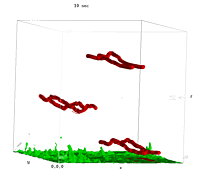 |
 |
Convective Boundary Layer |
last modified July 2002, Michael Frech, Frank Holzäpfel
The decay of wake vortices in a convectively driven atmospheric boundary layer is investigated by means of large-eddy simulations (LES). This was test case II of the EC-project WAVENC which enabled comparisons of the numerical codes of CERFACS and IST, University Lisboa and DLR. The results indicate - assuming sufficient resolution - a relative independence of wake vortex evolution from specific pecularities of the different codes.
A manuscript was published which deals with the CBL together with an
encounter assessment of aircraft flying through the CBL:
Wake Vortices in a Convective Boundary Layer
and Their Influence on Following Aircraft
Frank Holzäpfel, Thomas Gerz, Michael Frech, and Andreas Dörnbrack
Journal of Aircraft, Vol. 37, No. 6, 2000, pp. 1001-1007
Abstract
The decay of three wake vortex pairs of B-747 aircraft in an evolving and convectively driven atmospheric boundary layer is investigated by means of large-eddy simulations (LES). Convective boundary layers are considered as being hazardous as the updraft velocities of a thermal may compensate the induced descent speed of the vortex pair such that the vortices stall in the flight path. The LES results illustrate that (i) the primary rectilinear vortices are rapidly deformed on the scale of alternating updraft and downdraft regions; (ii) parts of the vortices stay on flight level but are quickly eroded by the turbulence of the updraft; (iii) longest living sections of the vortices are found in regions of relatively calm downward flow which augments their descent. Strip theory calculations are used to illustrate the temporal and spatial development of lift and rolling moments experienced by a following medium weight class B-737 aircraft. Characteristics of the respective distributions are analysed. Initially, the maximum rolling moments slightly exceed the available roll control of the B-737. After 60 seconds the probability of rolling moments exceeding 50 % of the roll control has decreased to 0.009 % in a safety corridor around the glide path.
In the following animations isosurfaces of the lambda Eigenvector = -0.5 and temperature T= 14.8K are shown. The wake vortices are identified using the lambda_2 Eigenvector proposed by Jeong and Hussain (JFM 285, 1995).
Click on one of the following images to view an animation of the simulation:
The perspective view:
| animated gif file | mpeg movie |
 |
 |
The side view of the same simulation:
| animated gif file | mpeg movie |
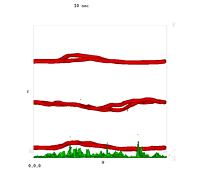 |
 |
and the top view:
| animated gif file | mpeg movie |
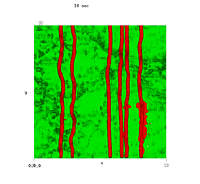 |
 |
Click on the following images to view an animation of some results of the
encounter assessment. Contour plots of normalized lift LWV/L0
,(L0=m*g)
| animated gif file | mpeg movie |
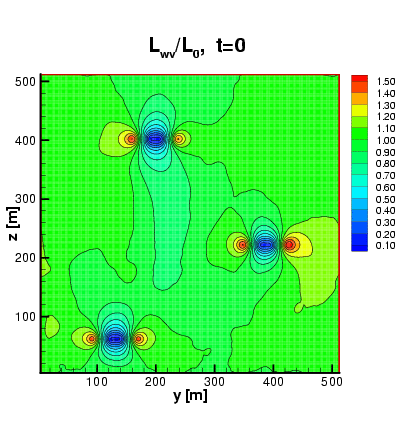 |
 |
and rolling moments MWV/0.5MC (0.5MC=50% of
the available roll control; a level considered as acceptabel) which are exerted
in average on B-737 crossing the domain on multiple flight path .
| animated gif file | mpeg movie |
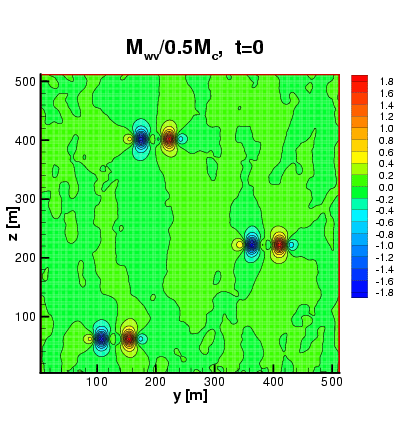 |
 |
The following figure depicts the probability of normalized rolling moments
exceeding threshold levels of |1| and |0.5|. Hazardous rolling moments above |1|
are likely to occur initially with a probability of 0.3%. After 60 seconds the
probability of hazardous rolling moments has decreased to 1% of the initial
probability. Please note that from 50s to 70s the probabilities decrease almost
two orders of magnitude. This means that even strong variations of the
acceptable probability (or variations of the acceptable threshold level) lead to
only marginal time shifts for the definition of a hazardous time span in the
CBL.